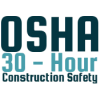
“@-Leisure” is proud to be partnered with industry-leading AdvanceOnline Solutions, Inc., an OSHA-Authorized Online Outreach Training Provider, to provide training programs to help keep your employees safe on the job. OSHA courses will be completed on a third-party site (AdvanceOnline Solutions) which will open in a separate window. Successful completion of this course earns an official Department of Labor (DOL) OSHA 30-Hour completion card that is valid nationwide for the construction industry.
Successful completion of this course earns an OSHA 30-hour Department of Labor (DOL) card that is valid nationwide for the construction industry. Learn More.
Course Details & Benefits:
This course has 27 lessons, with the 27th lesson being a final exam; each lesson has required labs and an exam. You will have 3 attempts to score a minimum of 70% on each lesson exam, as well as the final exam. The final exam is cumulative and will cover material from the entire course.
This course will take users approximately 30 hours, with a maximum allotment of 7.5 hours per day. As a result, this course must be delivered over a minimum of four days.
This course is intended for construction workers and supervisors, and anyone involved in the construction industry. OSHA recommends Outreach Training Program courses as an orientation to occupational safety and health for workers. Workers must receive additional training, when required by OSHA standards, on the specific hazards of the job.
Course topics include: Introduction to OSHA, Managing Safety and Health, Struck and Caught Hazards, Personal Protective Equipment (PPE), Hearing Conservation, Respiratory Protection, Lead and Crystalline Silica, Asbestos, GHS Hazard Communication, Electrical Safety, Hand and Power Tools, Fall Protection, Ladder Safety, Excavations, Scaffolds, Crane Safety, Heavy Equipment, Forklift Safety, Materials Handling, Permit-Required Confined Spaces, Fire Safety, Welding and Cutting, Concrete and Masonry, Steel Erection, and Ergonomics.
This course has these features and more.
- Multimedia
- Narration Interactivity
- Easy navigation
- Supplementary material
- Links to regulations
- Real-world scenarios
- Objective-based exams
- Continuing Education Units
After taking this course, you will be able to:
- Explain the importance of OSHA in providing a safe and healthful workplace to workers covered by OSHA
- Recognize how management plays a role to create a healthy and safe work environment through safety and health programs, worksite analysis to identify potential hazards on site, and levels of controls used to control exposure to hazardous materials and situations
- Identify the struck-by and caught-in or caught-between hazards associated with serious construction-related injuries
- Recognize the appropriate PPE to use based on a workplace evaluation and the types of hazards present
- Identify the appropriate hearing protection for your workplace based on the hazards of excessive noise, the types of noise, the results of a noise-monitoring program, and the OSHA rules for hearing protection
- Identify the appropriate respiratory protection for your workplace based on the types of airborne contaminants, the functions of different respirators, and the OSHA rules for respiratory protection
- Identify hazards posed by lead and crystalline silica in construction and how to control and avoid them
- Recognize the hazards of asbestos and identify ways to stay safe as you work in and around asbestos, including monitoring, communication, training, medical surveillance, PPE, and engineering controls
- Identify the elements of the Hazard Communication Standard, identify physical and health hazards of chemicals included on a Hazardous Chemical Inventory, recognize the information required on Safety Data Sheets (SDS) and warning labels, as well as how they are used and maintained, and the meaning of pictograms, under the Globally Harmonized System (GHS), and identify training program requirements
- Identify safe work practices for electricity, including recognizing electrical terms, basic electrical safety principles, and electrical safety regulations
- Recognize the safety hazards associated with non-powered hand tools and identify hazards related to powered hand tools
- Recognize types of fall hazards and how to prevent falls in your work environment by using appropriate fall protection
- Recognize ladder hazards, types of ladder-related injuries, and how to select, inspect, and maintain ladders
- Identify the dangers involved in excavations and the safe work practices for employees working in or near trenches and excavations
- Recognize the types of scaffolds and how to safely use them
- Identify the safety requirements for working with or near cranes, including how to avoid accidents and how to recognize hazards
- Recognize the safe work practices for working with or near heavy equipment
- Recognize safe operating procedures for forklifts, workplace hazards, and how to handle special types of forklifts
- Identify how to properly use, maintain, store, and dispose of materials
- Identify a confined space, its hazards, the OSHA requirements for confined spaces, and the duties and responsibilities of confined space workers
- Identify methods of fire prevention and describe OSHA requirements for fire protection
- Outline the general safety requirements for welding and cutting and list the safety precautions
- Identify the OSHA safety requirements for construction operations involving concrete and masonry
- Recognize the OSHA safety requirements for steel erection activities
- Recognize the role ergonomics plays in helping construction workers avoid work-related MSDs and identify how to avoid on-the-job injury when performing different types of activities.
Upon completion of this course, students will receive a certificate of completion which is good for 90 days. About 4-6 weeks after completion, your OSHA approved card will be delivered to you by mail.
Resources:
- OSHA also defines Program Jurisdiction Restrictions. Outreach Training Programs are limited to OSHA Jurisdiction only. Student course completion cards can only be issued for students within U.S. jurisdiction (the 50 States and certain U.S. Territories).
- You must complete this training within 180 days.

